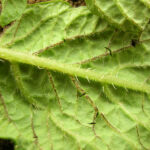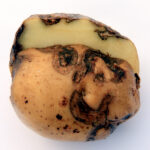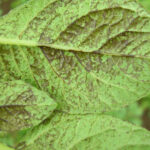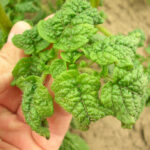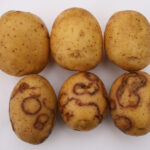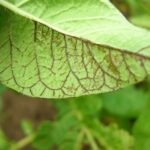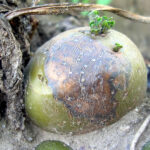Polish name: Wirus Y
English name: Potato virus Y, PVY
Kod EPPO: PVY000
Gallery
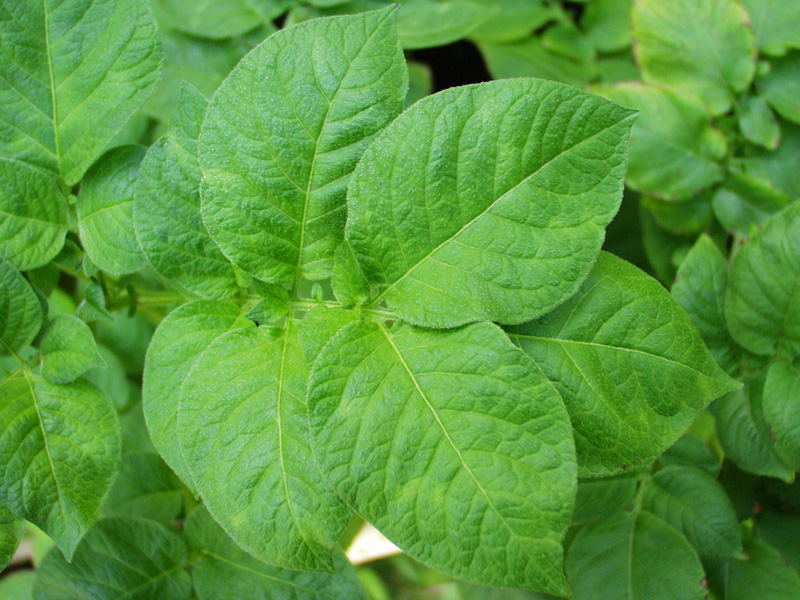
Weak mosaic on the leaves of potato plants infected with PVY
(photo by S. Wróbel)

Strong mosaic on the leaves of potato plants infected with PVY
(photo by S. Wróbel)
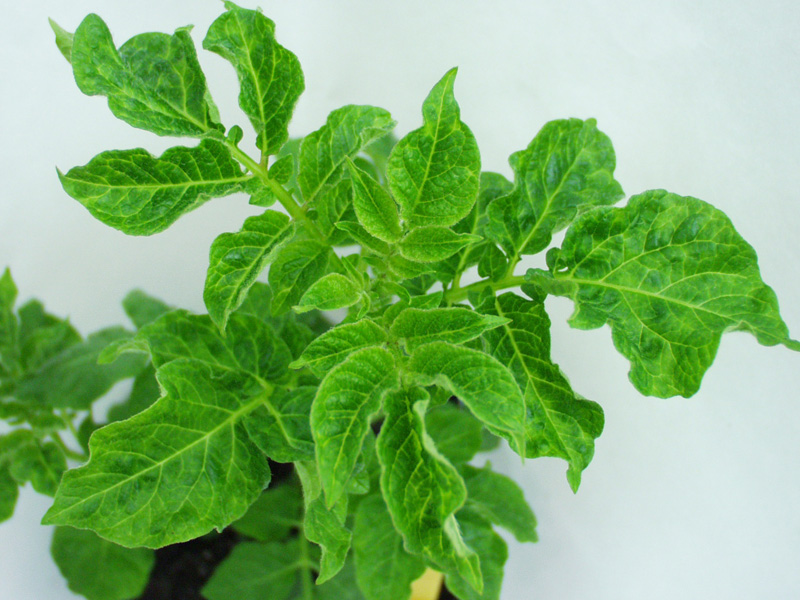
Severe mosaic on the leaves of potato plants infected with PVY
(photo by S. Wróbel)
- Liściozwis – charakterystyczny objaw porażenia PVY (fot. S. Wróbel)
- Nekrozy nerwów po dolnej stronie blaszki liściowej – objaw porażenie PVY (fot. S. Wróbel)
- Objawy porażenia PVYNTN na bulwach nasilają się z upływem czasu przechowywania (fot. S. Wróbel)
- Przy stosowaniu oleju mineralnego do ochrony przez PVY, tłuste plamy mogą również powstawać w przestrzeniach międzynerwowych na liściach (fot. S. Wróbel)
- Silna infekcja PVY objawia się na niektórych odmianach pomarszczeniem blaszek liściowych i ich zdrobnieniem (fot. S. Wróbel)
- Szczep PVYNTN wywołuje objawy porażenia również na bulwach w postaci nekrotycznych pierścieni (fot. S. Wróbel)
- Tłuste nekrozy nerwów po zastosowaniu oprysków olejem mineralnym są często mylone z objawami infekcji PVY (fot. S. Wróbel)
- Uszkodzenia bulw po niewłaściwym zastosowaniu środków zawierających dikwat (fot. S. Wróbel)
- Uszkodzenia bulw po niewłaściwym zastosowaniu środków zawierających dikwat (fot. S. Wróbel)
Characteristics and description of the disease
PVX belongs to plant viruses of the Potexvirus genus, Flexiviridae family. It was first discovered in 1931 in the United Kingdom. Once prevalent in Poland, it is currently essentially absent. Polish seed production and cultivation have effectively eliminated it by introducing resistant varieties. It sporadically appears only with seed materials imported from abroad. From 2006 to 2012, it was fairly common in Northern Ireland.
The primary hosts of the X virus are plants from the Solanaceae family (e.g., tobacco, peppers, tomatoes), but also turnips (Brassica rapa), some legumes (currently Fabaceae), and weeds. PVX infection is mainly spread mechanically through leaf contact and abrasions during maintenance procedures. It can be introduced to a plantation from the outside by people, animals, or tools that had contact with infected plants. Aphids do not transmit this virus. Some insects, like the Colorado potato beetle, grasshoppers, and green dock leafhoppers, may be accidental vectors. There are reports that PVX can also be transmitted by the spores of Synchytrium endobioticum (potato wart).
In case of mild or latent infection, yield losses are slight – up to a few percent. Reductions of up to 30% are commonly cited. Older studies indicate that yields can be lower by up to 75%. The harm of PVX significantly increases with complex infections involving other viruses. Since 2015, seed material in Poland is officially tested for this virus. Current legal regulations do not specify the maximum infection of PVX for different qualification levels but rather the sum for six evaluated viruses (PVY, PVM, PVS, PVA, PVX, PLRV). The highest allowable percentage of virus-infected tubers cannot exceed 10% for the lowest class – EU class B. In the Czech Republic, due to its low harm, the detected infection is multiplied by a factor of 0.33.
Symptoms of infection: The intensity of PVX infection symptoms depends on the susceptibility of varieties and weather conditions. Symptoms are more visible in cloudy weather and lower temperatures (16-20°C). Infection can also be asymptomatic. The most common symptoms during vegetation are:
- Mild to strong mosaics on leaves, irregular spots of light and dark green (photo 1X). Other colors, such as brown or yellow, are not associated with viral infection. Mosaics may be more pronounced when PVX occurs in the plant together with PVA or PVY. In the presence of the latter, PVX concentration increases significantly. Mosaics often have a light green shade.
- Deformation and wrinkling of the leaf blade (photo 2X), waving of its edges – more common when this virus is present in the plant together with PVA or in varieties susceptible to PVX.
- Varieties with hypersensitivity (HR) may exhibit stronger necroses and leaf deformation at the infection site, but the virus does not spread further within the plant.
- Point or streak necroses on leaves or in tubers.
Protection methods: The basic method is the frequent exchange of seedlings for qualified material free of viruses. Planting resistant varieties also reduces the risk of infection. Since 2015, no research has been conducted in Poland to determine the resistance of potato varieties to PVX. However, for many varieties in the Polish registry, this resistance is specified. In the case of many foreign, unregistered varieties, this resistance is often provided in characteristics on the websites of breeders.
Applying as much spatial isolation (distance from other potato plantations) for this virus does not have much significance. It is essential to regularly disinfect machines, clothing, and tools due to the potential transfer of the virus. This applies mainly to plantations of unknown health status.
It is also important to remove sources of infection, i.e., plants infected with viruses, from the field along with the tubers – this is called negative selection. One should not be too reluctant in this process because leaving a suspicious plant in the field, hoping for higher yields, can lead to the detrimental increase of virus infection in neighboring plants and, consequently, in seed plantations – degradation or even disqualification.
A very effective method to limit the flow of viruses from above-ground parts to tubers is early shoot destruction. This is a commonly performed procedure in seed plantations. For PVX, due to its method of transmission, the only recommended method is the chemical method, commonly known as desiccation. It involves applying appropriate sprays to plants, causing them to dry up. Applying the agent in inappropriate weather conditions can contribute to defects in tubers. This is particularly important in the cultivation of potatoes for food processing (chips and fries). Foreign studies indicate that during prolonged drought, spraying with Reglone 200 SL or its equivalent in a full single dose may cause internal discoloration of the flesh in some varieties. Contact of tubers with this agent can cause noticeable damage. This can occur when tubers are very shallow in the furrow, and after the treatment, intense rain falls, washing the agent from the stems into the tubers in the soil. To achieve the best results, it is recommended to use split doses. The first dose aims to destroy the upper leaf mass so that the agent can precisely cover the exposed stems during the second treatment. The second half of the recommended dose of the agent should be applied 3-6 days after the first treatment. The speed of absorption of agents by leaves and stems varies and depends, among other things, on the soil on which potatoes grow. They are most rapidly absorbed by plants growing on heavier soils (clay, loamy sand). In the case of Reglone 200 SL, rain showers after 15 minutes from application generally do not affect its effectiveness, whereas after applying Basta 150 SL, according to the label, 4 hours of rain-free weather are required.
Compiled by: Dr. Hab. Sławomir Wróbel


